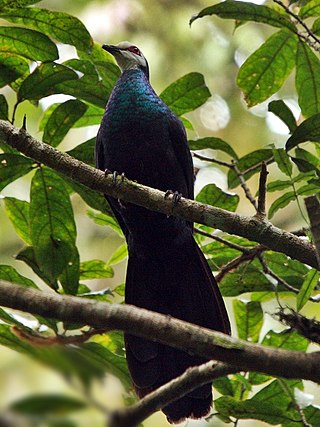
Turacoena is a small genus of doves in the family Columbidae that are found in Indonesia.

Myiopsitta is a genus of parrot in the family Psittacidae. They are native to South America, but are found all over Europe, as well. They are known as an invasive species due to the crop damage they cause, which greatly affects the wildlife all across Europe. The monk parakeet is sometimes considered monotypic within the genus.
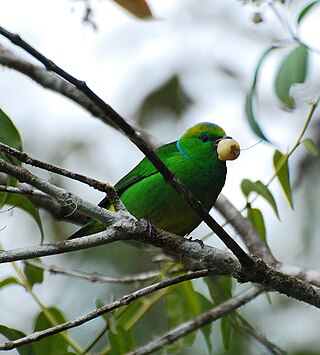
Chlorophonia is a genus of finches in the family Fringillidae. The Chlorophonias are endemic to the Neotropics. They are small, mostly bright green birds that inhabit humid forests and nearby habitats, especially in highlands.

Chaetocercus is a genus of hummingbirds in the family Trochilidae.

Catamenia is a genus of atypical seedeaters. Formerly placed in the Emberizidae, they are now placed in the tanager family Thraupidae.

Chalcostigma is a genus of South American hummingbirds in the family Trochilidae.
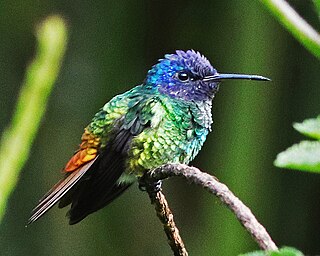
Chrysuronia is a genus of hummingbirds in the family Trochilidae, all of which are native to Central and South America.
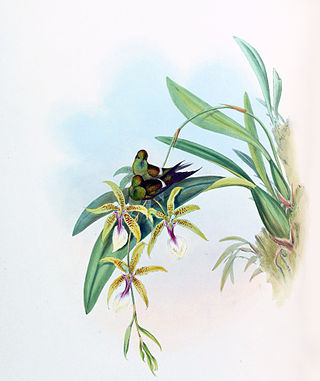
Letitia's thorntail, also known as the coppery thorntail, is a very poorly known species of hummingbird in the "coquettes" tribe Lesbiini of subfamily Lesbiinae. It was named after Letizia del Gallo Roccagiovine (1848–1863), granddaughter of the ornithologist Charles Bonaparte.

The racket-tailed coquette is a species of hummingbird in the family Trochilidae native to northeastern South America.

Woodnymphs are hummingbirds in the genus Thalurania. Males are green and violet-blue, while females are green with white-tipped tails and at least partially whitish underparts. Both sexes have an almost straight, entirely black bill and little or no white post-ocular spot. They are found in forest and tall second growth. The species in this genus are almost entirely allo- or parapatric, and a species is present virtually everywhere in the tropical humid Neotropics.

Hydropsalis is a genus of nightjars in the family Caprimulgidae. The species are widely distributed across the tropical and subtropical regions of the New World.

Lurocalis is a genus of nightjar in the family Caprimulgidae. The species are found in Central and South America.

Chalcopsitta is a genus of parrot in the family Psittaculidae and the subfamily Loriinae. All three species are native to New Guinea and western offshore islands. The name Chalcopsitta is derived from the Greek khalkos meaning "bronze" and psitta meaning "parrot".
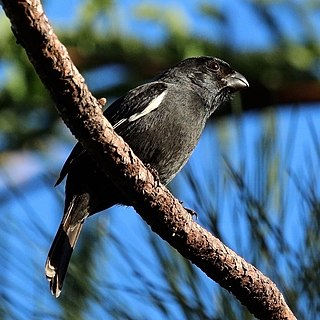
Melopyrrha is a genus of passerine birds in the tanager family Thraupidae. It is made up of four extant species endemic to the Greater Antilles, along with 1 possibly extinct species from the island of Saint Kitts in the Lesser Antilles.

Blythipicus is a genus of birds in the woodpecker family Picidae that are found in Southeast Asia.

Veniliornis is a genus of birds in the woodpecker family Picidae. They are native to Central and South America.

Saucerottia is a genus of birds in the family Trochilidae, or hummingbirds.

Cyanomitra is a genus of African sunbirds. Its members are sometimes included in Nectarinia.
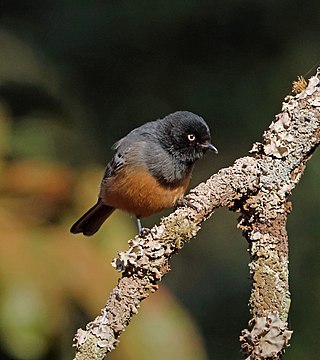
Melaniparus is a genus of birds in the tit family. The species were formerly placed in the speciose genus Parus but were moved to Melaniparus based on a molecular phylogenetic analysis published in 2013 that showed that the members formed a distinct clade. The genus Melaniparus had originally been introduced by the French naturalist Charles Lucien Bonaparte in 1850. The type species was subsequently designated as the southern black tit. The name of the genus combines the Ancient Greek melas, melanos "black" and the genus Parus introduced by Carl Linnaeus in 1758.

Yungipicus is a genus of woodpeckers in the family Picidae native to Asia. The species in this genus were previously placed in the genus Dendrocopos.

























